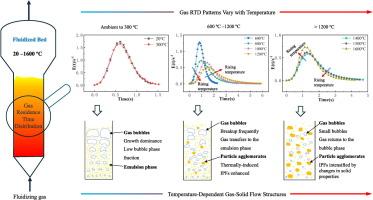Insights into gas-solid flow structures in fluidized beds up to 1600 °C via analysis of gas residence time distributions
IF 4.5
2区 工程技术
Q2 ENGINEERING, CHEMICAL
引用次数: 0
Abstract
This study investigates gas residence time distributions (RTDs) in a fluidized bed of Al₂O₃ particles at temperatures ranging from ambient to 1600 °C, focusing on the impact of temperature on gas back-mixing and flow patterns. We find that at low temperatures (up to 300 °C), gas flows in a near-plug flow pattern, represented by narrow RTD curves with early peaks. As temperature increases to 600 °C, the RTD curves broaden, featuring delayed peaks due to bubble breakup and enhanced gas drag. Between 800 °C and 1200 °C, significant deviations from plug flow emerge, driven by stronger interparticle forces and increased gas transfer to the emulsion phase. Interestingly, beyond 1200 °C, the RTD curves shift back toward plug flow, influenced by intensified interparticle forces and physicochemical changes in the bed materials.

通过分析气体停留时间分布深入了解温度高达 1600 °C 的流化床中的气固流动结构
本研究调查了 Al₂O₃ 颗粒流化床在环境温度到 1600 ° C 之间的气体停留时间分布 (RTD),重点研究温度对气体回混和流动模式的影响。我们发现,在低温条件下(最高温度为 300 °C),气体的流动模式接近于塞流,表现为具有早期峰值的窄 RTD 曲线。温度升高到 600 ℃ 时,RTD 曲线变宽,由于气泡破裂和气体阻力增强,峰值延迟。在 800 °C 至 1200 °C 之间,由于粒子间的作用力增强以及气体向乳液相的转移增加,出现了明显的塞流偏差。有趣的是,当温度超过 1200 °C,受颗粒间作用力增强和床层材料物理化学变化的影响,RTD 曲线又向塞流方向移动。
本文章由计算机程序翻译,如有差异,请以英文原文为准。
求助全文
约1分钟内获得全文
求助全文
来源期刊

Powder Technology
工程技术-工程:化工
CiteScore
9.90
自引率
15.40%
发文量
1047
审稿时长
46 days
期刊介绍:
Powder Technology is an International Journal on the Science and Technology of Wet and Dry Particulate Systems. Powder Technology publishes papers on all aspects of the formation of particles and their characterisation and on the study of systems containing particulate solids. No limitation is imposed on the size of the particles, which may range from nanometre scale, as in pigments or aerosols, to that of mined or quarried materials. The following list of topics is not intended to be comprehensive, but rather to indicate typical subjects which fall within the scope of the journal's interests:
Formation and synthesis of particles by precipitation and other methods.
Modification of particles by agglomeration, coating, comminution and attrition.
Characterisation of the size, shape, surface area, pore structure and strength of particles and agglomerates (including the origins and effects of inter particle forces).
Packing, failure, flow and permeability of assemblies of particles.
Particle-particle interactions and suspension rheology.
Handling and processing operations such as slurry flow, fluidization, pneumatic conveying.
Interactions between particles and their environment, including delivery of particulate products to the body.
Applications of particle technology in production of pharmaceuticals, chemicals, foods, pigments, structural, and functional materials and in environmental and energy related matters.
For materials-oriented contributions we are looking for articles revealing the effect of particle/powder characteristics (size, morphology and composition, in that order) on material performance or functionality and, ideally, comparison to any industrial standard.
 求助内容:
求助内容: 应助结果提醒方式:
应助结果提醒方式:


